30 Apr 2025
Philip Portman
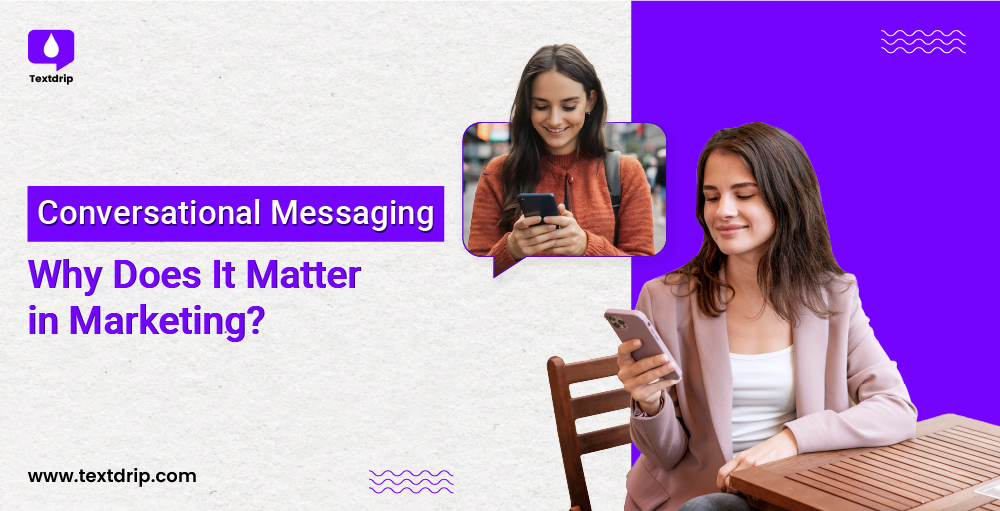
30 Apr 2025
Philip Portman
These days, customers crave genuine connections and quick responses. That’s why businesses are adopting advanced two-way text messaging communication strategies to be more human-centric and interactive. They are trying their best to integrate the future of text message marketing, a new emerging trend – conversational messaging into their overall marketing strategy. It helps businesses make interactions with customers more personal and meaningful. So, it builds strong customer relationships and boosts customer engagement. Simply put, you talk to your consumers individually instead of all at once in conversational texting. With conversational SMS, customers feel texting a business is like texting their friend – quick, easy, and natural. It helps you grow your business, increase conversations, and improve customer experience.
Keep reading this blog to understand more about conversational messaging and how it can benefit both your customers and business.
Let’s first start with understanding what conversational messaging is.
Conversational messaging is an advanced two-way communication that uses artificial intelligence to craft genuine conversations between customers and your business. In conversational messaging, back-and-forth conversations take place. Conversational texting aims to improve customer service, build strong customer relationships, and drive sales. It is the practice of engaging with potential and existing clients via one-to-one interactions across various messaging channels such as SMS, MMS, Live web chat, instant messaging, and RCS messaging.
Here is a quick comparison between conversational messaging and two-way messaging.
| Feature | Conversational Messaging | Two-Way Texting |
| Definition | It lets businesses and customers engage in natural and ongoing chats. | Two-way messaging lets both the business and customers send and receive text messages. |
| Communication Style | It feels like a real conversation with the back-and-forth flow. | It allows basic message exchange without maintaining a conversational tone. |
| User Experience | User feel heard and engaged because the interaction is personalized. | Users can respond to messages but the interaction feels more transactional. |
| Automation | It uses AI or chatbots to maintain the context and provide intelligent responses. | In two-way texting automated replies are used but they usually lack deep context or adaptive responses. |
| Engagement Depth | Builds stronger relationships via meaningful interactions. | It enables simple feedback or responses but don’t involve deep engagement. |
| Example | A customer chats with the travel agency to customize vacation plans in real-time. | A customer replies to a shipping update about delivery timing. |
Here is how conversational texting differs from traditional messaging.
| Feature | Traditional Messaging | Conversational Messaging |
| Communication Style | One-way, business-to-customer. It usually involves sending mass text messages with no expectation of response. | Two-way interaction. Customers can ask questions, give a reply, and engage in a meaningful conversation. |
| Response Time | Delayed or no response. You need to do manual follow-up through email or calls. | Real-time or instant reply through SMS automation, bots, or live agents. |
| Tone and Personalization | Generic, impersonal. It generally uses the same messages for all recipients. | Friendly, human-like, and personalized based on user data, behaviour, or past interactions. |
| User Experience | Static and transactional. Traditional messaging often interrupts rather than engages. | Dynamic and engaging. It feels like you’re chatting with a helpful friend. |
| Engagement Level | In traditional messaging engagement level is low. Customers mostly ignore or delete messages. | Conversational messaging offers high engagement. It encourages participation, feedback, and questions. |
| Goal | The main goal here is to push promotions, alerts, or announcements. | The main goal of conversational messaging is to build relationships, solve problems, and guide decisions. |
| Message Format | In traditional messaging message format is plain text. | In conversational messaging message format is rich format. It includes links, buttons, images, and emojis for better engagement. |
| Automation and AI Integration | It rarely uses automation. Mostly linear and manual communication. | It frequently uses AI, chatbots, and CRMs to deliver smart and contextual responses. |
| Conversion Potential | Low because of its impersonal nature and friction in the buying journey. | Higher because it nurtures trust and resolves objections in real time. |
| Customer Support Capability | Disconnected. It requires separate support channels like calls and emails. | Integrated. It combines marketing, sales, and support in a single chat thread. |
| Scalability | Limited. It requires a lot of manual input. | It is highly scalable via automation while retaining personalization. |
Conversational messaging is a hassle-free approach to providing customers with direct, instant, and concise responses to their inquiries without putting them on hold. Customers prefer immediate solutions to their problems, and conversational messages are an efficient and smooth way to meet their needs. Here are the main benefits of conversational messaging.
It increases sales opportunities because it lets you quickly answer customers’ questions and gather more customer information. Besides, it offers higher engagement rates. So you can qualify more leads and drive more sales.
For example, if you run an eCommerce brand, you can send SMS for abandoned cart reminders, exclusive offers, upselling, etc. It encourages customers to complete their purchases and increase sales.
As conversational messaging is two-way communication between customers and businesses, customers engage more. They will most likely purchase when they feel understood.
For example, a restaurant should use conversational SMS to quickly respond to customer inquiries regarding restaurant hours, promotions, etc. So customers receive quick answers without waiting long.
Conversational messaging uses a personalized approach via one-on-one messaging. This means that each SMS is personal to each individual. Besides, it allows businesses to learn more about a customer’s needs and preferences.
For example, an online fashion brand can use conversational messaging to recommend dresses based on customer’s purchase history. If the customers’ replies show interest, an AI chatbot can provide more tailored recommendations. It increases engagement and the chance of a sale.
The most important benefit of conversational messaging is it strengthens customer relationships. Whenever customers get one-on-one attention and messages, it makes them feel valued. So, it enhances their perception of your brand and encourages them to continue purchasing from your brand.
For example, a quick
Hey Emily, would you like help finding your size?
feels better than
Buy NOW – 50% OFF.
Conversational messaging improves customer support and satisfaction. Nowadays, customers don’t want to wait days for an email reply. It solves problems quickly, often before customers decide to leave.
When you use conversational messaging to communicate with your customers, it can save your business money. This type of conversational messaging is a cost-effective approach which can reduce customer service costs.
In short, conversational messaging offers these benefits, including being included in your marketing strategy, which is smart.
Finally, if you’ve decided to build a conversational SMS marketing campaign, here are a few ways in which you can use conversational SMS.
Businesses can use conversational messaging to handle customer support inquiries via one-on-one communication. They can use conversational messaging to resolve issues, handle consumer complaints, and respond to customer inquiries.
For example, here is how a customer service representative can fix the issue of a customer’s missing email through conversational SMS.
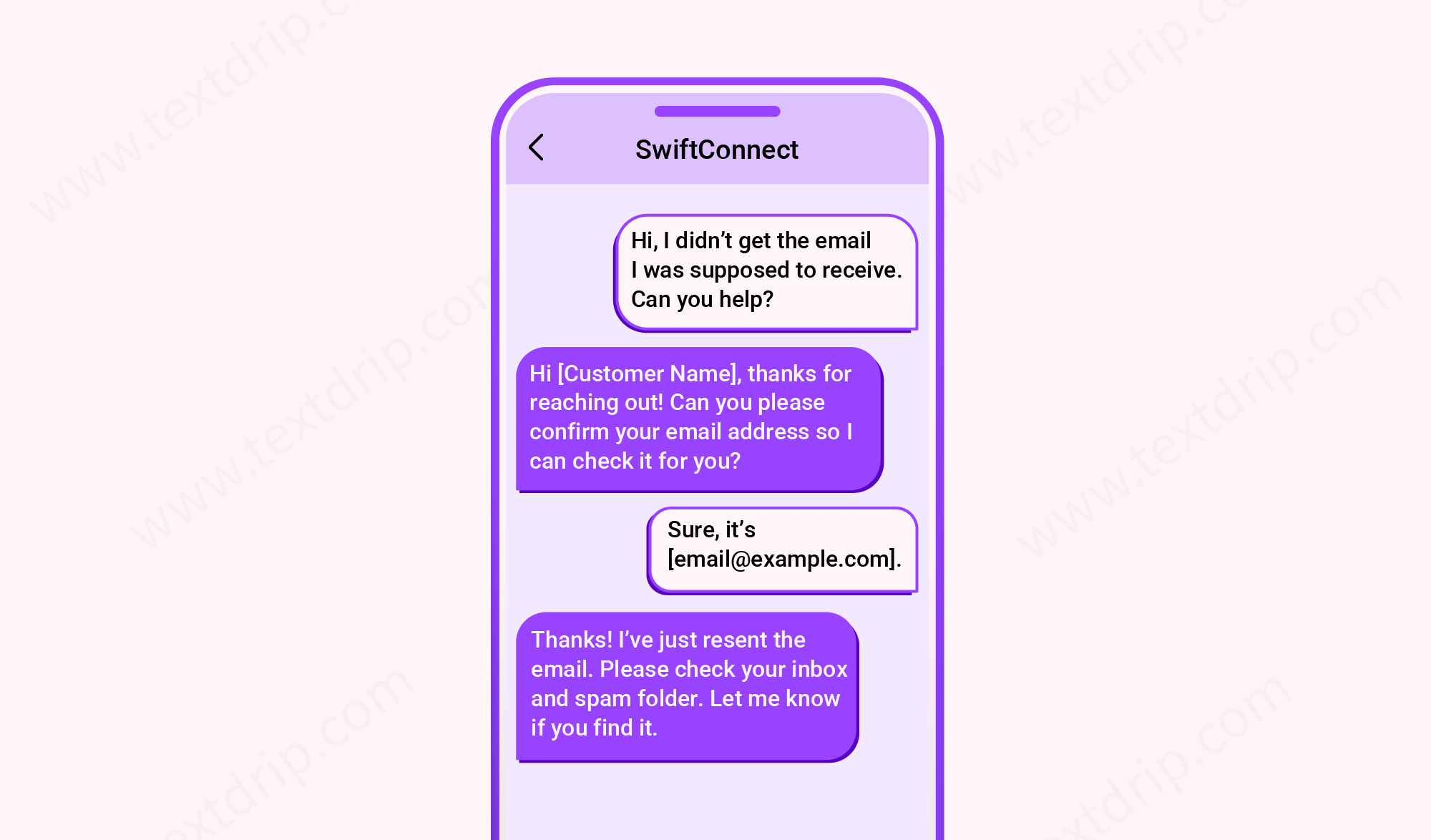
Using conversational SMS, businesses can quickly and in real-time answer customers’ questions regarding services, products, and other inquiries.
For example, here is how a fashion brand can help the customer find a suitable dress.
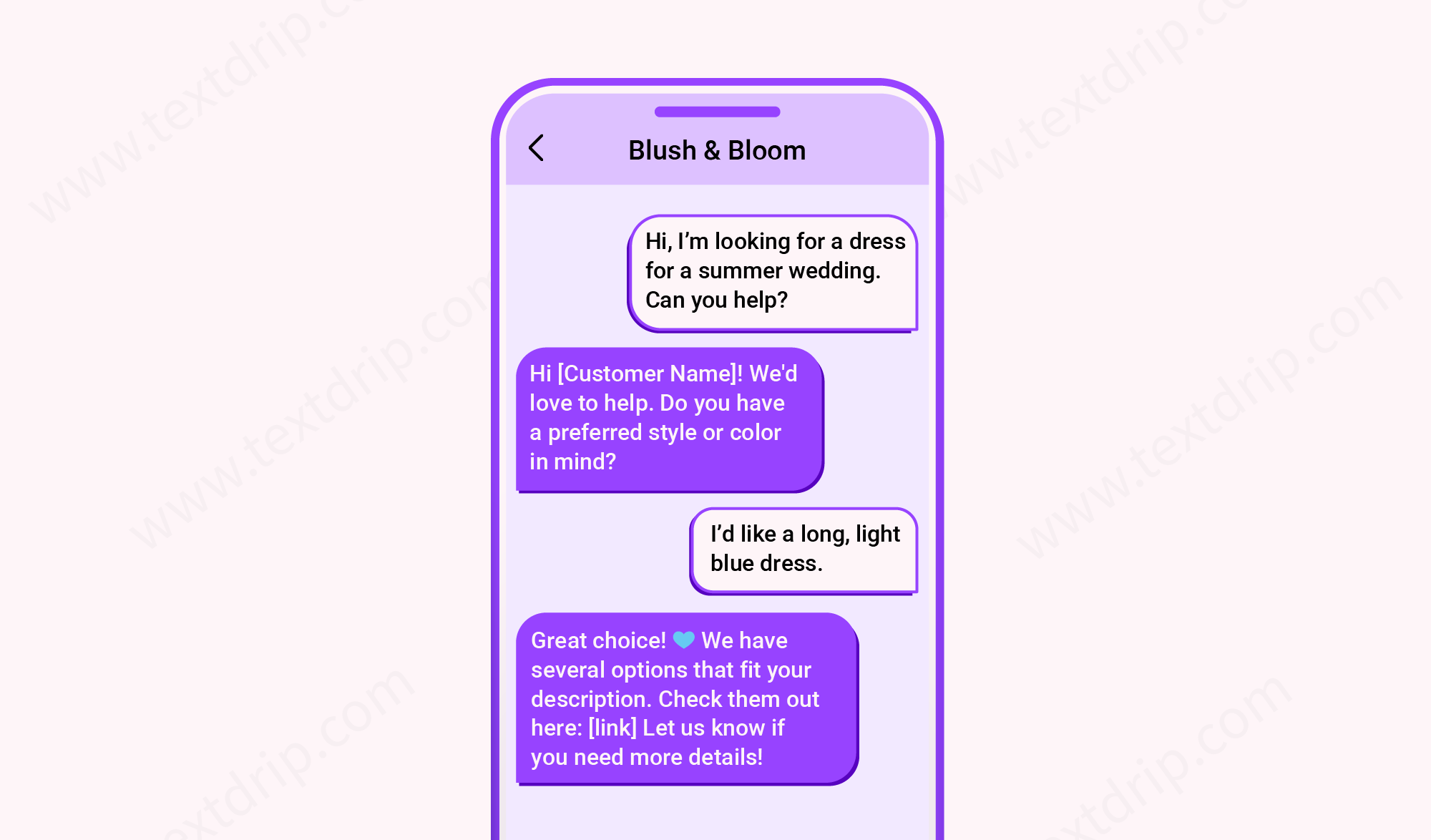
Conversational messaging is a perfect way to collect feedback from customers. This 2-way text conversation can help businesses receive quality feedback and develop stronger customer relationships.
The following example shows how a business can collect customer insights to help decide which chocolate flavour they should offer in the winter season.
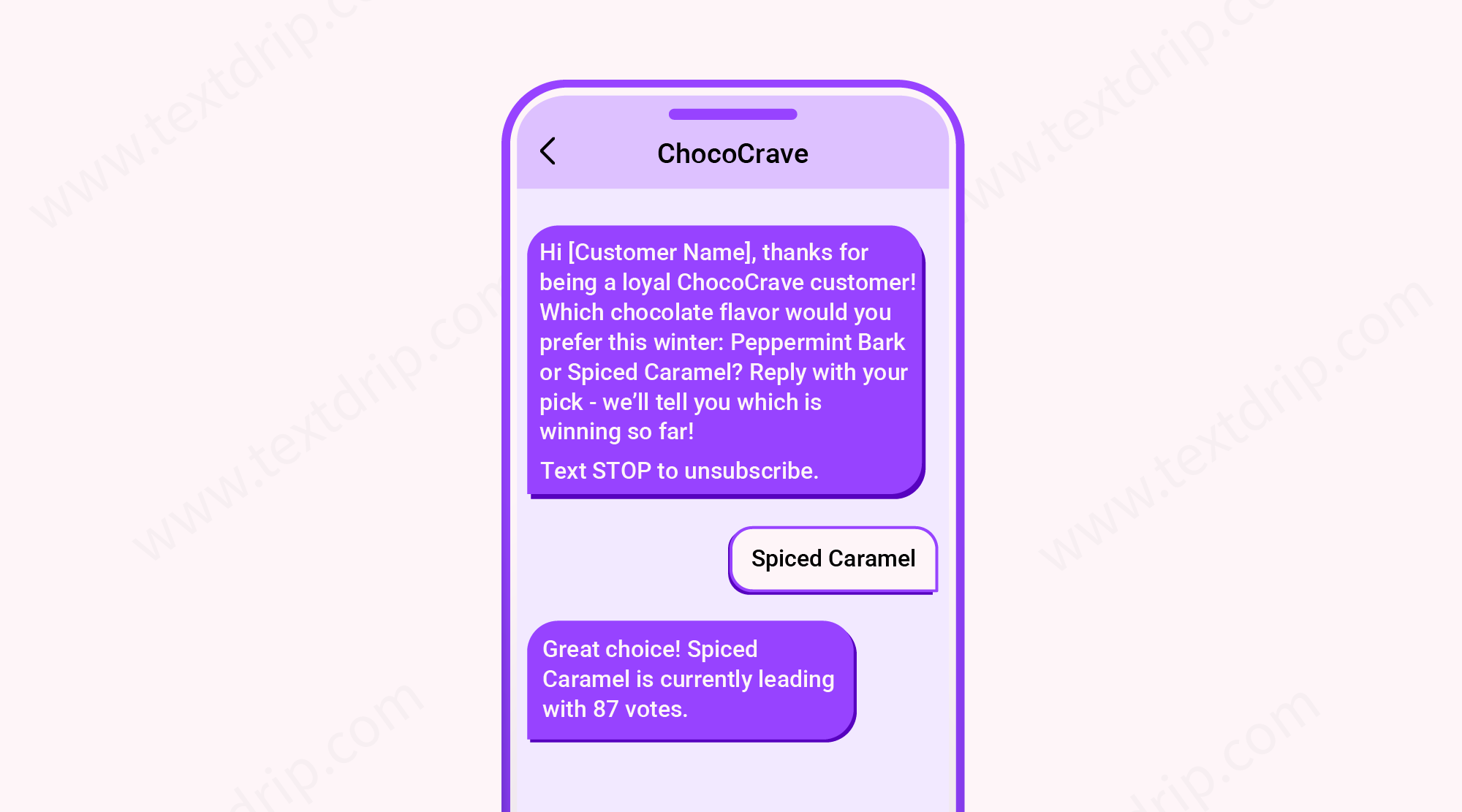
Conversational SMS allows businesses to communicate updates about products or price changes to customers quickly. Ensure to keep them informed.
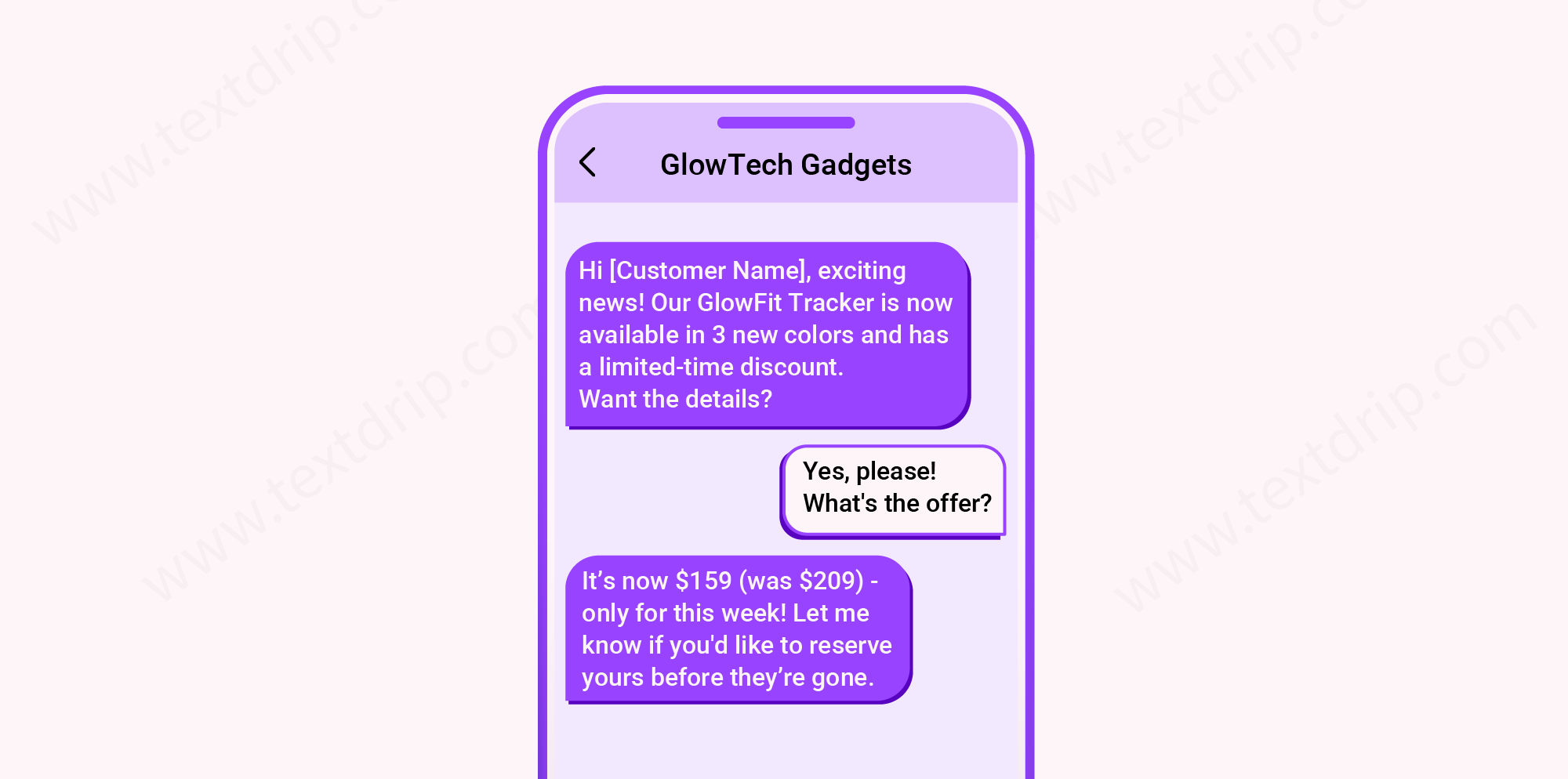
Businesses can use conversational texting and send reminder texts to customers about their abandoned carts. It will encourage them to complete their purchases.
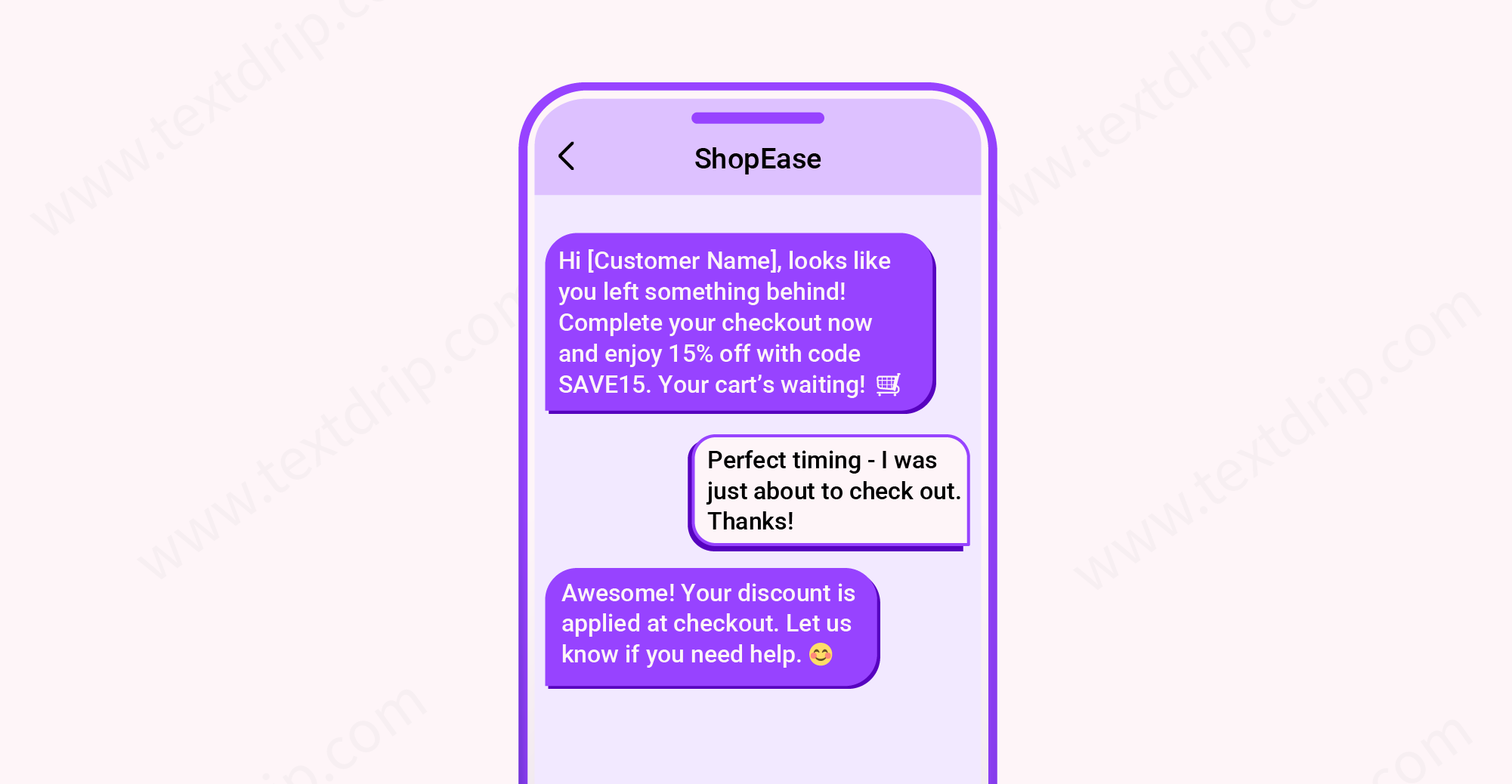
Businesses can use conversational messaging to notify customers when their orders will be shipped, provide tracking information, and answer shipping-related questions.
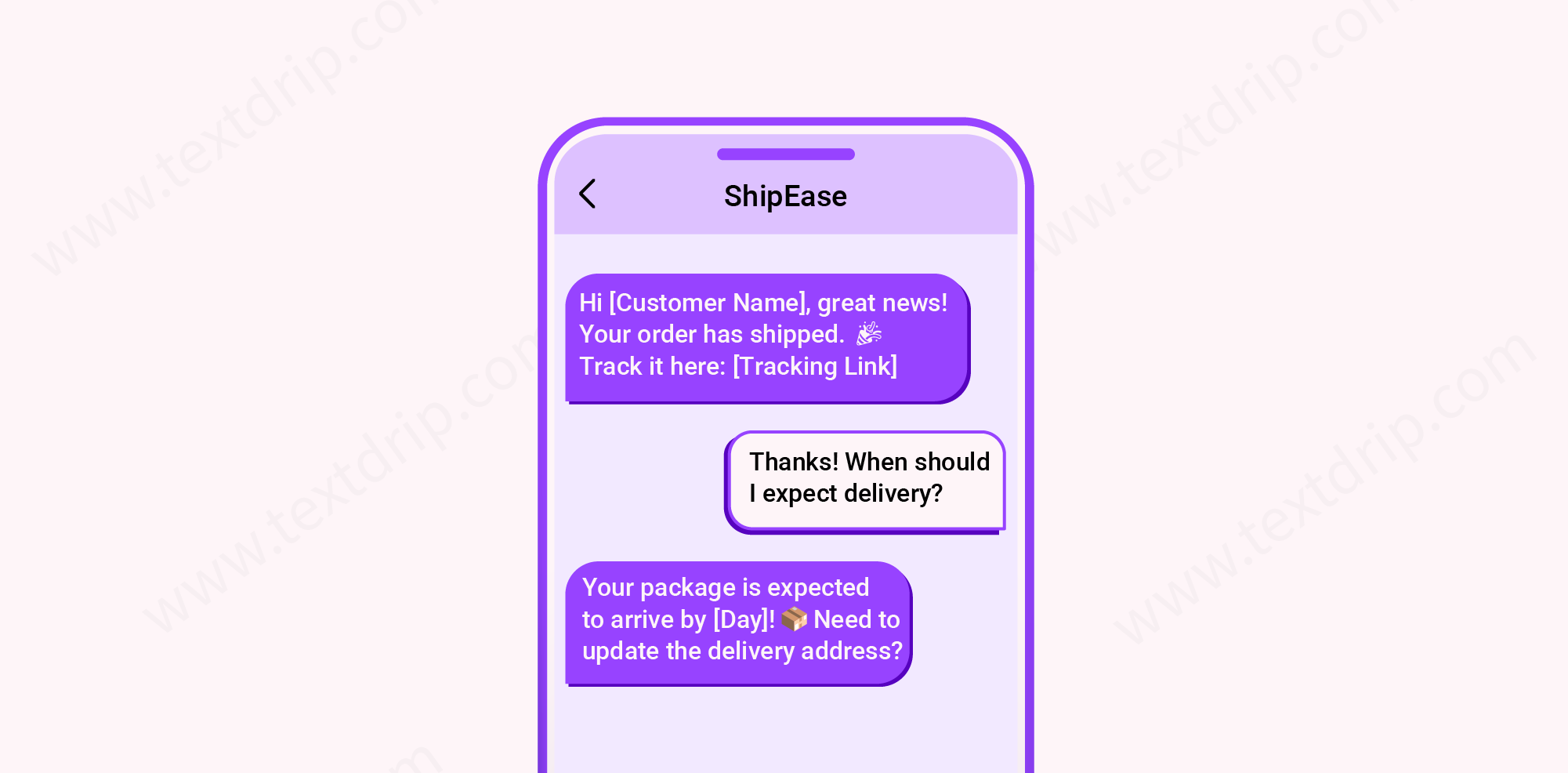
Businesses can offer live chat support to their customers about product location, availability, or features via SMS when they’re browsing physical stores.
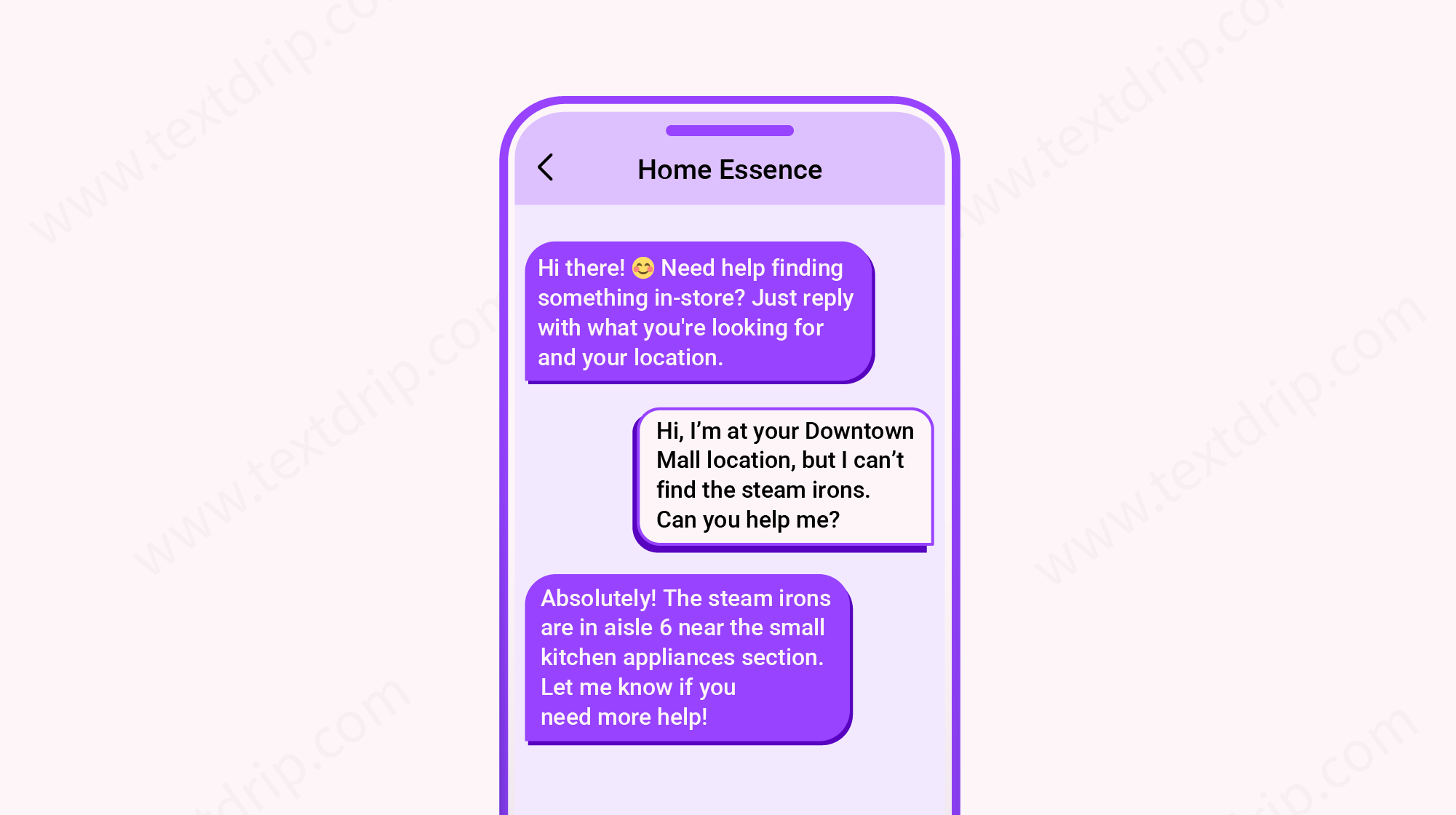
If you want to implement conversational messaging right, here are some golden rules that you need to follow. It will help you enhance your conversational messaging strategy.
Conversational messaging allows you to connect with your customers in real-time. Therefore, ensure they feel like this is a real two-way conversation with your business. You can use customers’ names, preferences, and purchase histories to create a customized conversation. Personalization improves customer satisfaction. Even if you use bots or automation, ensure your messages don’t look and feel robotic.
AI and automation let you communicate with your customers 24*7 and reduce the need for any manual responses. Therefore, you can set up auto-replies for common questions or use the AI chatbots on your website so that customers get answers even after working hours. Here, keep in mind that for basic queries, AI chatbots and automation are good to use, but for complex ones, you should offer live support through agents. Ensure the handoff from chatbots to live support feels seamless.
When you use multiple channels for conversational messaging, your business can reach more leads and customers. Each channel has different features and values, and each customer will have different preferences. Therefore, you must diversify your messaging channels so you can easily reach your target audience and maintain consistent communication.
You should start small. For example, start with one use case, such as cart recovery or lead qualification. After that, expand. If you try to automate everything at once, it can be challenging for you.
You must get permission before messaging someone. Respect your customers’ time and offer an opt-out easily.
The future of conversational messaging (future text messages) is AI-driven, hyper-personalized, and cross-channel. Technology is getting advanced daily, and AI and automation are the major parts of conversational SMS. Using these tools, you can have more personal, quicker, and better conversations with your customers. Here is what you can expect in future.
AI will constantly enable businesses to provide personalized experiences. It will analyze customer data, behaviours, and preferences and, based on it, customize conversations, product recommendations, and send targeted promotions via SMS. Platforms like Positiveintent.ai take this a step further by combining emotional intelligence with smart automation.
It allow brands to engage customers with context-aware and emotionally resonant messages. AI continues to improve in understanding context, emotions, and tone. In short, you can expect bots that really get you.
The future of conversational messaging involves smoother and deeper integration with other messaging platforms such as Messenger, WhatsApp, Instagram, etc. Customers might start the conversation on Instagram, continue via SMS, and end it on your website chat without repeating themselves. AI can simplify these conversations and ensure consistency and context across various channels.
The omnichannel messaging approach will let you provide a unified and smooth experience to your customers no matter how your customer decides to engage. Messaging platforms like Textdrip enable smooth integration across channels and seamless channel-switching. On the other hand, solutions like Positiveintent.ai improve this further by using intelligent automation to detect customer intent, personalize responses, and drive meaningful engagement across all touchpoints.
In the future, messaging will not just be text. It will include voice commands, video chats, and AR elements, which will be part of the conversational experience.
In the future, AI-powered conversational SMS will use tools that will read sentiments and moods, and based on them, they will adjust tone and recommendations.
By using AI, businesses can use predictive analytics to forecast customer needs and behaviours. They will understand trends, predict future interactions, and proactively reach out with timely offers, reminders, or customer support. It will ensure that you remain one step ahead of customer expectations.
Imagine you get messages not just about what you bought but also about what you liked last year and what others like you are buying now. Future conversational SMS will help you send hyper-personalized campaigns to your customers. It will certainly improve conversions, sales, and ROI.
Generally, many brands are stuck here. They love the idea of conversational text messaging but don’t know where to start or which platform to choose.
Let us simplify it for you.
Before you finalize any platform and tool for conversational SMS, ask these questions.
Your search ends here if you are searching for a solution that ticks all these boxes. Textdrip is a platform with impressive features like two-way texting, SMS automation, personalization, and AI-based smart text response intent detection and classification.
SMS marketing is constantly evolving, and if you include interactive, customer-centric messaging, you can turn each conversation into a deeper engagement opportunity. So, don’t treat your SMS marketing strategy like email – one-way communication (one-way promotional messages). Instead, implement two-way conversational SMS that offers personalized recommendations, drives higher engagement, and gathers customer insights. It helps drive conversions, build long-term relationships, and boost customer retention.
Use the AI-powered marketing automation platform Textdrip to send personalized and engaging conversational messages to your customers. Its impressive features, such as contact segmentation, two-way texting, SMS automation, personalization, and quick responses, help you make your SMS marketing more personal, effective, and valuable than ever. Book a demo or start using Textdrip today and experience how it can boost your marketing strategy.
Conversational messaging provides instant, human-like interaction, making customers feel heard and valued. It reduces wait times, simplifies queries, and enhances overall satisfaction, turning casual visitors into loyal customers.
AI can power chatbots, analyze sentiment, and automate personalized responses in conversational messaging, allowing businesses to scale one-on-one conversations without sacrificing quality.
By automating FAQs and basic tasks, conversational texting deflects common inquiries from human agents. It resolves issues faster and allows support teams to focus on more complex customer needs.
Chatbots typically operate on web or app-based interfaces, while conversational SMS is delivered via standard text messaging. SMS is more direct and doesn’t require internet access or third-party apps.